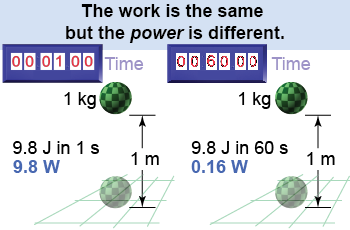|

| In everyday conversation the words energy and power are often used interchangeably, but the true meanings are different. Energy is the ability to do physical work and is measured in joules. The same amount of work, however, can be done either slowly or quickly. For example, lifting a 1 kg ball by 1 m takes a minimum of 9.8 J of work. Suppose you do it very slowly, taking a whole minute. How is that different from doing it quickly, say in one second? Clearly there is a difference. Nonetheless, the total work done is the same in both cases. |

|
The difference is the rate at which the work is done. The rate at which work is done, or the rate at which energy is transferred, is called power, and is calculated using equation (9.5). 
|
| (9.5) | | | P | = | power (W) | | ΔE | = | change in energy (J) | | W | = | work done (J) | | Δt | = | time duration (s) |
| Power
|
|
Power is an indication of the level of “effort” required to perform a given amount of work. If you want to move a boulder a few meters, then one person can do it in a few minutes using only a modest amount of power. If you want to move the boulder the same distance but more quickly (in a few seconds!), then you will need much more power—that can only be delivered by a team of horses or a front end loader machine. 
|
Whereas work and energy are measured in joules, power is measured in joules per second. A power of one joule per second (J/s) is one watt (W). The watt is named in honor of James Watt, a Scottish engineer who developed the first practical steam engine and thereby provided the power for the industrial revolution. Doing 9.8 J of work in 60 s requires 0.16 W—approximately the power output of a small mouse. Doing the same 9.8 J of work in 1 s, as shown in the figure above, requires 9.8 W of power, which is 60 times greater. 
|
How much energy does an incandescent light bulb rated at 100 W use in one hour? | Asked: | energy ΔE used by the light bulb | | Given: | power of the light bulb P = 100 W; time that bulb is on Δt = 1 hr | | Relationships: | power P = ΔE/Δt | | Solution: | Time is usually expressed in seconds, but we are given it in hours. Convert time to seconds: Solve for E by multiplying the power equation by the elapsed time Δt: | | Answer: | 360,000 J | 
|
If an engine can produce 670 J of energy in 1 min, how many watts can it output? - 11 W
- 670 W
- 40,200 W
- not enough information
 |
The correct answer is a. Power is energy divided by time or P = (670 J)/(60 s) = 11 W. 
|
| |
|

